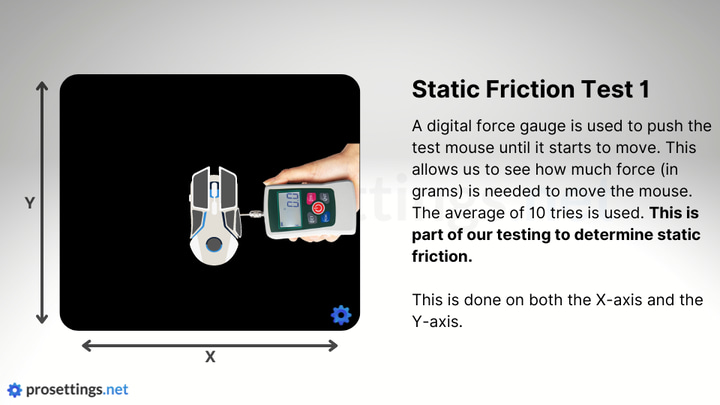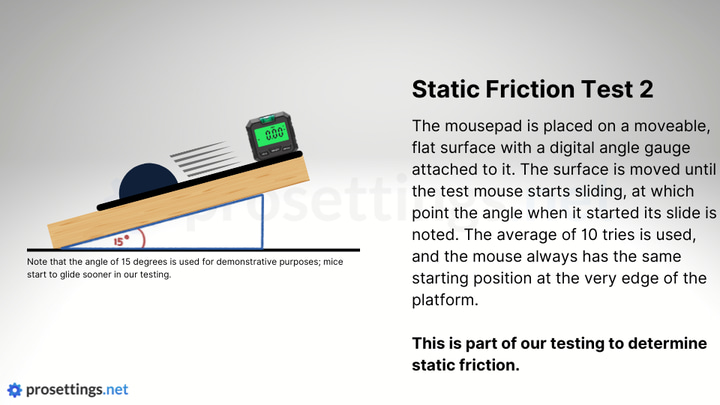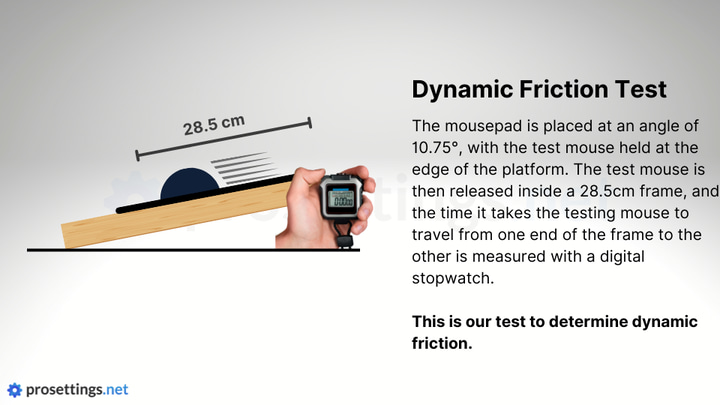How we test mousepads

As you may or may not know, mousepads are a particularly difficult product to review. Their performance can greatly vary depending on factors such as room temperature, humidity, and the age of the pad. How a pad feels also depends on how you’re using it: the weight of your mouse, the type mouse feet you’re using, the amount of force you apply to your mouse when gaming, …
In an effort to bring more objective parameters to our mousepad reviews, we’ve come up with a series of tests that yield objective results in a controlled, repeatable environment. For these tests, we use a Razer DeathAdder V2 Pro with lightly used skates and a 200 gram counterweight added on top of the mouse in order to simulate the pressure that gamers put on their mouse when gaming.
We are aware of the fact that these tests are not perfect: testing a mousepad in a ‘lab environment’ is different from experiencing it in games, but since we’re testing a large variety of mousepads under the same conditions, we can compare the data to see how each pad stacks up to the pack. We are always working on improving our testing, so this article may change over time.
A large amount of credit goes to Kenneth ‘Drench’ W for coming up with the majority of these tests and working out the testing methods and required gear. The subreddit /r/mousepadreview has also had a big influence on these testing methods thanks to the small but dedicated community over there who are passionate about gaming mousepads.
Static Friction Test 1 – Digital Force Gauge
For this test, we place our test mouse on the mousepad, and use a force gauge to press against the sides of the mouse until it starts to move. We take the average of 10 tries in order to come up with the average force required in order to move a mouse on the testing mousepad. We do this on the X-axis as well as the Y-axis. This allows us to calculate the difference between the X-axis and Y-axis (if there is any) since this can greatly influence the feeling of a mousepad.
The higher the number, the more static friction.

Static Friction Test 2 – Digital Angle Gauge
As a second test of determining static friction, we place the mousepad and the test mouse on a flat, moveable surface. To this surface, we attach a digital (zeroed) angle gauge. We slowly move the testing rig until the mouse starts to slide. At that point, we stop moving and note the angle at which the mouse has started moving.
Factors that might influence these results include the rate at which the testing rig was moved as well as the position of the mouse on the rig. In order to eliminate random/bad results as much as possible, we always place the testing mouse at the very edge of the movable platform. We take the average of 10 tries in order to come up with the average angle at which the mouse starts moving.
The higher the number, the more static friction.

Dynamic Friction Test – Digital Stopwatch
Unfortunately, dynamic friction is a lot harder to test since this involves determining how much stopping force a mousepad has. In order to test this objectively, we place a mousepad at an angle of 10.75 degrees. We then place the testing mouse at the very edge of the testing rig, and release it. We time how long it takes the mouse to travel across a 28.5 centimeter frame.
Note that these 28.5 centimeters are measured by placing the mouse inside a frame. Therefore, it’s important to note that the sensor doesn’t travel the full 28.5 centimeters. This is of no consequence to the test results since we’re not testing the sensor, but it is important to note when interpreting the results. We release the test mouse without applying any force to it, and measure the time it takes the testing mouse to travel the entire frame with a digital stopwatch.
The higher the number, the more dynamic friction.

Interpreting these results
It’s of course very important to note that our tests are rather ‘cut and dry’. Using a mousepad for gaming means that you will be applying varying degrees of force to your mouse, and you will need to make micro adjustments as well as large flicks. Sweat and skin oils also come into play when gaming, as well as the humidity and temperature of your room. All of this to say: these testing results are useful, but they don’t tell the whole story.
We are big fans of data, but we also believe that the feeling of a product in actual usage matters. That’s why we don’t limit ourselves to just reiterating spec sheets when making our reviews: the human element is important as well. In our mousepad reviews, you will see these test results being referred to and used multiple times, but we don’t judge a mousepad solely based on these numbers.
Still, this data can be incredibly useful for comparing different mousepads, or to determine how a mousepad might feel. A pad with a high dynamic friction and a high static friction will be a rather controlling, ‘muddy’ mousepad, for example, whilst a mousepad with a low dynamic and static friction will trend towards speed and feel rather slick.
Comparing these numbers across different mousepads can also be incredibly valuable. If you’re happy with the dynamic friction of your current pad but you want one with just a bit more static friction, you can find just that in our data. You can then read up on the overall experience that you get with the pad by reading our review of it, and thus make an informed choice on your next purchase.
As mentioned before, we will keep working on our testing methodology and come up with new, more accurate testing where necessary.



In order to test the actual dynamic friction, you just need to stop applying force on the digital gauge that you use to measure the static friction. Decrease the amount of pressure until the mouse stops moving
This is a better test because the difference between the amount of pressure that it takes to start moving the mouse and to keep moving the mouse will affect how consistent the mousepad is.
The current numbers aren’t really comparable to one another since one is in time and the other in a measure of pressure, the user simply can’t tell how close the numbers would be, or rather, how consistent the mousepad is,
Please add, thanks
Thank you for the input. However, the numbers in time and pressure aren’t supposed to be compared to one another. They are different tests using different equipment. We do take your feedback on board though and will take it into account when we further develop our testing!
Very good evaluation method.
Please test g640’s friction, it’s classic mousepad, had a lot fans.
Had any same X-Y-axis friction mousepad recommend?
Thanks.
i cant understand the mousepadlist. So whats the slowest mousepad? or the slowest 3 mousepads?
With mousepads, it goes as follows:
Higher friction is slower than lower friction
A higher friction angle is slower than a lower friction angle
A higher dynamic friction number is slower than a lower dynamic friction number
are you going to retest pads like the gigantus v2, g640, and qck with this method?
Yes, we’re in the process of testing all the pads that we still have. It’s worth noting that a lot of those older pads have been used and/or are older at this point in time. We will make note of that when creating our list with mousepad characteristics though!
Might also be worth giving some credit to the mousepad review subreddit –
https://www.reddit.com/r/MousepadReview/comments/vw7y4n/mastersheet_52_vaxee_pa_fantech_mp903_and/
We’ve been doing variations of these exact 3 tests for the last 3 years – cool that you’re adopting this set though as hopefully this version of objective testing will propogate
W
You’re right, I’ve added that to the article as well!
Much appreciated sir!
Also I’m unfamiliar with Drench personally, but if you speak with him (or if he reads this thread) please pass along that I’d be happy to discuss methodology with them to assist and help avoid some of the pitfalls that befell me developing these 3 tests. Same name on reddit (author of linked post above)
This is all really interesting, so I’ve sent you a PM on reddit with my work email in case you want to discuss this a bit further. Thanks so much for reaching out!
hey responded there sir!
Awesome!
Glad you like it! We’re excited to see what results we’re going to get using this testing method!